UNIT III
Accounting for Inland Branches
Concept of dependent branches; accounting aspects; debtors’ system, stock and debtor’s system, branch final accounts system and whole sale basis system
INTRODUCTION: -
A branch may be defined as section of an enterprise, geographically separated from the rest of the business, controlled by head office, and generally carrying on the same activities as of the enterprise. As a business grow, it may open up branches in different towns and cities in order to market its product/services over a large territory and thus increase its profit.
For example, Bata shoe Co. Ltd has branches in various cities all over the country. The same example holds good for a commercial bank also.
As per the provision of Companies Act, branch office in relation to a company means-
a) Any establishment described as a branch by the company; or
b) Any establishment carrying on either the same or substantially the same activity as that carried on by the head office of the company; or
c) Any establishment engaged in any production, processing or manufacture.
It should be mentioned that a branch is not a separate legal entity it is simply a segment of a business. From an accounting standpoint, a branch is a clearly identifiable profit centre. In order to exercise greater control over the branches it is necessary to ascertain profit or loss made by such branches separately. Apart from this, specialised accounting techni9have to be adopted for controlling various branches activities and for their smooth running both at the branch level and at the head office level. The system of accounting varies between different enterprises in accordance with their type of activities, methods of operation and the preference of their managements.
NEED FOR BRANCH ACCOUNTING
Ascertain the profitability of each branch separately for particular accounting period.
Ascertain the financial position of each branch separately at the end of that accounting period.
Assess the progress and performance of each branch
Incorporate the profit or loss made by the branch and its assets and liabilities in the firm's final accounts
Ascertain the requirements of cash and stock for each branch,
Ascertain whether the branch should expended or closed
TYPES OF BRANCHES
From accounting point of view, the branches can be divided into the following main cases:
1) HOME BRANCHES: -
a) Dependent Branches (Where the head office maintains all the accounts)
b) Independent Branches (Where the branch keeps its own accounts)
2) FOREIGN BRANCHES: -
They almost invariably trade independently and record their transaction in foreign currency.
Dependent Branches
When the policies and administration of a branch are totally controlled by the head office, who also maintains its accounts, the branch is called as dependent branch.
Independent Branches
Independent Branches are those which make purchases from outside, get goods from Head Office, supply goods to Head Office and fix the selling price by itself Thus an independent Branch enjoys a good amount of freedom like an American Son.
ACCOUNTING SYSTEM OF BRANCHES
The accounting arrangement of a branch depends upon its size, the type of activities, the methods of operation and the degree of control to be exercised by the head office. There are three main system of accounting for branches transaction, viz.
- Debtors System
- Stock and Debtors System
- Final Account system
This system of accounting is suitable for the small- size branches. Under this, a Branch Account is opened for each branch in the head office ledger. All the transaction relating to that branch is recorded in this account. The branch account is prepared in such a way that it discloses the profit or loss of the branch.
Head office may send goods to branch either at "cost price" or "selling price".
Cost price method: - under this method at the beginning of the year the branch Account is debited with the opening balances of asset such as stock, petty cash, furniture, prepaid expenses, etc. lying with the branch. Similarly, it is credited with the opening balance of liabilities of the branch such as, creditors, ots salary, rent, etc.
The branch is then debited with the amount of goods sent to the branch and other amounts remitted to meet various expenses such as, salaries, rent, rates, taxes, etc. Likewise, the branch account is credited with the return of goods by the branch and receipts from branches. At the year end, Branch Account is debited with the closing values of liabilities and credited with the closing values of assets. The difference between the two sides represents profit or loss for the branch for a particular period.
DEBTORS METHOD
Journal entries
1) For goods sent to branch
Branch A/c _______Dr.
To Goods Sent to Branch A/c
(Being goods sent to branch)
2) For goods returned by the branch
Goods Sent to Branch A/c _______Dr.
To Branch A/c
(Being goods returned by the branch)
3) For amount sent to branch for expenses
Branch A/c _______ Dr.
To Bank A/c
(Being cheque sent to branch for expenses)
4) For amount received from branch
Bank A/c _______ Dr.
To Branch A/c
(Being cash or cheque received from branch)
5) For closing goods sent to branch account
Goods Sent to Branch Alc Dr.
To Purchase A/c
(Being balance transferred to Trading Account)
6) For closing balances of assets at the branch
Branch Assets A/c ________ Dr. (Individually)
To Branch A/c
(Being closing balances of assets brought into account)
7) For closing balances of Liabilities at the branch
Branch A/c ________Dr.
To Branch Liabilities A/c (Individually)
(Being closing balances of liabilities brought into account)
8) For transferring Profit or Loss to General Profit and Loss Account
i) If Profit
Branch A/c _______ Dr.
To General Profit and Loss A/c
(Being branch profit transferred to General P & L A/c)
Ii) If Loss
General Profit and Loss A/c ________ Dr.
To Branch A/c
(Being branch loss transferred to General P & L A/c)
The closing balances of branch assets and liabilities are shown in the Balance Sheet
Of the head office. At the beginning of the next year, the entire numbers 6 and 7 are
Reversed so as to show opening balances in the Branch Account.
STOCK AND DEBTORS METHOD:
Under this method accounts relating to branch are maintained in a more comprehensive and detailed manner as compared to Debtors method. This method keeps a better control stock. Under this method separate accounts are prepared for various accounting function
This accounting procedure under this method depends upon the policy of head office with regard to pricing of goods send to branch. Head office may adopt one of the following methods for invoicing goods to branch.
- At cost price to head office.
- At selling price of the branch.
- At cost price plus fixed margin of profit. In this case branch may sell goods at higher or lower than the invoice price.
When goods have been invoiced to branch at cost price.
In this case following accounts are prepared.
a) Branch Stock Account
b) Goods sent to Branch Account
c) Branch Debtors Account
d) Branch Expenses Account
e) Branch Profit & Loss Account
f) Branch Cash Account
I) When goods are sent to the branch (at invoice price)
Branch Stock A/c _____ Dr.
To Goods Sent to Branch A/c
2) When goods are returned by the branch to the H.O. (at invoice price)
Goods Sent to Branch A/c _______ Dr.
To Branch Stock A/c
3) When sales are made by the branch
i) For Cash Sales
Cash A/c _______ Dr.
To Branch Stock A/c
Ii) For Credit Sales
Branch Debtors A/c _______ Dr.
To Branch Stock A/c
4) When Cash is Received from Debtors
Cash A/c ______ Dr.
To Branch Debtors A/c
5) For Sales Returns
Branch Stock A/c ________ Dr.
To Branch Debtors A/c
6) For discount allowed, bad debts, etc.
Branch Expenses A/c ________ Dr.
To Branch Debtors A/c
7) For Shortage of Stock
Branch Adjustment A/c ________ Dr.(with amount of loading)
Branch P & L A/c ________ Dr. (with cost of shortage)
To Branch Stock A/c
For surplus at branch, the reverse entry will be passed.
8) For Branch Expenses paid in Cash
Branch Expenses A/c ______ Dr.
To Cash A/c
9) For Closing Branch Expenses Account
Branch P&L A/c ______ Dr.
To Branch Expenses A/c
10) For Adjustment of Loading on the Opening Stock
Stock Reserve A/c ______ Dr.
To Branch Adjustment A/c
11) For Adjustment of Loading on the Closing Stock
Branch Adjustment A/c ______ Dr.
To Stock Reserve A/c
12) For Adjustment Loading Goods sent to Branch
Goods Sent to Branch A/c ________ Dr.
To Branch Adjustment A/c
13) For Transfer of Gross Profit
Branch Adjustment A/c _______ Dr.
To Branch P & L A/c
Examples
Q.1 (AT COST)
Suri is having his Head office at Mumbai and Branch Office at Nasik. Prepare the branch Account in the books of the Head Office from the following transaction with the branch:
PARTICULARS | AMOUNT | PARTICULARS | AMOUNT |
Opening Balance at Branch: |
| Amounts remitted to the Branch for : |
|
- Petty Cash | 1,000 | - Petty Cash Expenses | 4,000 |
- Stock | 39,500 | - Salary | 12,000 |
- Debtors | 21,000 | - Rent and Taxes | 3,500 |
Goods Supplied to Branch during the year | 3,10,000 | Closing balances ay Branch: |
|
Amounts remitted by the branch |
| - Petty | 950 |
- Cash Sales | 1,13,200 | - Debtors | 53,000 |
- Realisation from Debtors | 2,30,300 | - Stock | 26,500 |
SOLUTION: -
IN THE BOOKS OF H.O.
Dr. NASIK BRANCH ACCOUNT. Cr.
PARTICULARS | AMOUNT | PARTICULARS | AMOUNT |
To Balance b/d |
| By Bank (Remittance): |
|
Branch petty cash | 1,000 | - Petty Cash Expenses | 4,000 |
Branch Stock | 39,500 | - Salary | 12,000 |
Branch Debtors | 21,000 | - Rent and Taxes | 3,500 |
To Goods sent to Branch | 3,10,000 | Closing balance at Branch |
|
To cash remitted for: |
| - Petty Cash | 950 |
Petty Cash Expenses | 4,000 | - Debtors | 53,000 |
Salary | 12,000 | - Stock | 26,500 |
Rent | 3,500 |
|
|
To General P&L (Bal Fig) | 32,950 |
|
|
TOTAL | 4,23,950 | TOTAL | 4,23,950 |
Q.2 (INVOICE PRICE)
D of Delhi have a branch at Madras. Goods are sent by the Head Office at Invoice Price which is at the Profit of 25% on Cost Price. All the Expenses of the branch are paid by the Head Office. From the following particulars, prepare Branch Account in Head Office Books
BALANCES | OPENING | CLOSING |
Stock at invoice | 11,000 | 13,000 |
Debtors | 1,700 | 2,000 |
Petty Cash | 100 | 25 |
TOTAL | 12,800 | 15,025 |
Goods sent to branch at invoice price Rs. 20,000.
Expenses made by head office: -Rent Rs.600, Wages Rs.200, Salaries Rs.900
Remittance made to Head Office: - Cash Sales Rs. 2,650, Cash collected from debtors Rs. 21,000
Goods Returned by Branch at Invoice Price Rs.400
SOLUTION: -
IN THE BOOKS OF HEAD OFFICE
Dr. MADRAS BRANCH A/c. Cr.
PARTICULARS | AMOUNT | AMOUNT | PARTICULARS | AMOUNT | AMOUNT |
To Balance b/d |
|
| By Stock Reserve A/c b/d(Load on OP. Stock 11,000 X 25/125) |
| 2,200 |
Stock (IP) |
| 11,000 | By Bank |
|
|
Debtors |
| 1,700 | Cash Sales | 2,650 |
|
Petty Cash |
| 100 | Cash collected from Debtors | 21,000 | 23,650 |
To Goods sent to Branch (IP) |
| 20,000 | By Goods sent to branch (Returns at IP) |
| 400 |
To Bank (Expenses): |
|
| By Goods sent to branch (19,600 X 25/125; net Loading) |
| 3,920 |
Rent | 600 |
| By Balance c/d |
|
|
Wages | 200 |
| Stock (IP) | 13,000 |
|
Salaries | 900 | 1,700 | Debtors | 2,000 |
|
To Stock Reserve A/c c/d(Load on Cl. Stock 13,000 X 25/125) |
| 2,600 | Petty Cash | 25 | 15,025 |
To Net Profit tfd to general P&L (Bal Fig) |
| 8,095 |
|
|
|
TOTAL |
| 45,195 | TOTAL |
| 45,195 |
Note: Goods are sent by Head Office at @ 25% on Cost Price.
So, Cost + Profit = Invoice Price
100 + 25 = 125
Profit charged by Head Office is 1/5 or 20% of Invoice Price.
Q.3 (INVOICE PRICE)
One M.P. Head Office has a branch at Berhampur to which goods are invoiced at cost plus 20% .from the following particulars prepare the Branch Account in the Head Office Books :
PARTICULARS | AMOUNT |
Goods sent to Branch at invoice Price | 2,11,872 |
Total Sales | 2,06,400 |
Cash Sales | 1,10,400 |
Cash received from Branch Debtors | 88,000 |
Branch Debtors at commencement | 24,000 |
Branch Stock at commencement at Invoice price | 7,680 |
Branch Stock at Close of the period at Invoice Price | 13,440 |
SOLUTION: -
IN THE BOOKS OF M.P. HEAD OFFICE
Dr. BERHAMPUR BRANCH ACCOUNT. Cr.
PARTICULARS | AMOUNT | AMOUNT | PARTICULARS | AMOUNT | AMOUNT |
To Balance b/d |
|
| By Stock Reserve A/c b/d(Load on OP. Stock) |
| 1,280 |
Stock (IP) |
| 7,680 | By Bank |
|
|
Debtors |
| 24,000 | Cash Sales | 1,10,400 |
|
To Goods sent to Branch (IP) |
| 2,11,872 | Cash collected from Debtors | 88,000 | 1,98,400 |
To Stock Reserve A/c c/d(Load on Cl. Stock) |
| 2,240 | By Goods sent to branch (2,11,872 X 20/120; net Loading) |
| 35,312 |
To Net Profit tfd to general P&L (Bal Fig) |
| 34,640 | By Balance c/d |
|
|
|
|
| Stock (IP) | 13,440 |
|
|
|
| Debtors | 32,000 | 45,440 |
|
|
|
|
|
|
|
|
|
|
|
|
|
|
|
|
|
|
TOTAL |
| 2,80,432 | TOTAL |
| 2,80,432 |
Working Note:
Dr. BERHAMPUR BRANCH DEBTORS ACCOUNT. Cr.
PARTICULARS | AMOUNT | PARTICULARS | AMOUNT |
To Balance b/d | 24,000 | By Cash | 88,000 |
To Credit Sales | 96,000 | By balance c/d (balancing figure) | 32,000 |
TOTAL | 1,20,000 | TOTAL | 1,20,000 |
(2)
Total Sales =2,06,400
Less: - Cash Sales =1,10,400
Credit Sales =96,000
(3)
Goods are sent by Head Office at @ 20% on Cost Price.
So, Cost + Profit = Invoice Price
100 + 20 = 120
Profit charged by Head Office is 1/6 of Invoice Price.
Q.4 (AT COST)
The Canada commercial company invoiced goods to its Jaipur Branch at cost. The head office paid all the branch expenses from its bank except petty cash expenses which were Paid by the branch. From the following details relating to the branch, prepare
(1): Branch Stock A/c
(2)Branch Debtors A/c
(3)Branch Expenses A/c
(4)Branch P&L A/c
PARTICULARS | AMOUNT | PARTICULARS | AMOUNT |
Stock (Opening) | 21,000 | Discount to Customer | 4,200 |
Debtors (Opening) | 37,800 | Bad Debts | 1,800 |
Petty Cash(Opening) | 600 | Goods returned by customers to branch | 1,500 |
Goods sent to H.O. | 78,000 | Salaries | 18,600 |
Goods returned to H.O. | 3,000 | Rent | 3,600 |
Cash Sales | 52,500 | Debtors(Closing) | 29,400 |
Advertisement | 2,400 | Petty Cash (Closing) | 300 |
Cash received from debtors | 85,500 | Credit Sales | 85,200 |
Stock(Closing) | 19,500 |
|
|
Allowances to Customer | 600 |
|
|
|
|
|
|
SOLUTION: -
Dr. BRANCH STOCK A/c. Cr.
PARTICULARS | AMOUNT | PARTICULARS | AMOUNT |
To Balance b/d | 21,000 | By Branch Cash | 52,500 |
To Goods sent to sent Branch | 78,000 | By Goods sent to Branch | 3,000 |
To Branch Debtors | 1,500 | By Branch Debtors | 85,200 |
To Branch P&L (Transfer) | 59,700 | By Balance c/d | 19,500 |
TOTAL | 1,60,200 | TOTAL | 1,60,200 |
Dr. BRANCH DEBTORS A/c. Cr.
PARTICULARS | AMOUNT | PARTICULARS | AMOUNT |
To Balance b/d | 37,800 | By Branch Cash | 85,500 |
To Branch Stock (Credit Sales) | 85,200 | By Branch expenses Bad Debts 1,800 Allowances 600 Discount 4,200
| 6,600 |
|
| By Branch Stock (Returns) | 1,500 |
|
| By Balance c/d | 29,400 |
TOTAL | 1,23,000 | TOTAL | 1,23,000 |
Dr. BRANCH EXPENSES A/c. Cr.
PARTICULARS | AMOUNT | PARTICULARS | AMOUNT |
To Branch Debtors | 6,600 | By Branch P&L | 31,500 |
To Bank Advertisement 2,400 Salaries 18,600 Rent 3,600 | 24,600 |
|
|
To Petty Expenses (600-300) | 300 |
|
|
|
|
|
|
TOTAL | 31,500 | TOTAL | 31,500 |
Dr. BRANCH PROFIT & LOSS A/c. Cr.
PARTICULARS | AMOUNT | PARTICULARS | AMOUNT |
To Branch Expenses | 31,500 | By Branch Stock | 59,700 |
To General P&L (Bal Fig) | 28,200 |
|
|
TOTAL | 59,700 | TOTAL | 59,700 |
Q.5 (AT COST)
The following are the details of ‘Indore Branch’ for the year 2018
PARTICULARS | AMOUNT | PARTICULARS | AMOUNT |
Opening stock | 6,000 | Salaries | 2,000 |
Opening Petty Cash | 500 | Rent | 1,500 |
Opening Debtors | 8,000 | Closing Stock | 8,000 |
Goods sent to Branch | 24,000 | Cash sent to Branch | 2,200 |
Goods returned by Branch | 800 | Discount Allowed | 100 |
Remittance from Branch | 33,500 | Bad Debts | 150 |
Returns from Debtors | 2,000 | Commission Paid | 750 |
Collection from Debtors | 34,000 | Closing Petty Cash | 450 |
Cash Sales | 1,500 | Closing Debtors | 9,000 |
Prepare: (1) Branch Stock A/c (2) Branch Debtors A/c (3) Branch Expenses A/c
(4) Branch P&L A/c (5) Branch Cash (6) Goods sent to Branch A/c
SOLUTION: -
Dr. BRANCH STOCK A/c. Cr.
PARTICULARS | AMOUNT | PARTICULARS | AMOUNT |
To Balance b/d | 6,000 | By Branch Cash (Cash Sales) | 1,500 |
To Goods sent to sent Branch | 24,000 | By Goods sent to Branch | 800 |
To Branch Debtors(Return Inwards) | 2,000 | By Branch Debtors(Credit Sales) | 37,250 |
To Branch P&L (Transfer) | 15,550 | By Balance c/d | 8,000 |
TOTAL | 47,550 | TOTAL | 47,550 |
Dr. BRANCH DEBTORS A/c. Cr.
PARTICULARS | AMOUNT | PARTICULARS | AMOUNT |
To Balance b/d | 8,000 | By Branch Cash (Received from Debtors) | 34,000 |
To Branch Stock (Credit Sales) (Bal Fig) | 37,250 | Branch expenses Bad Debts 150 Discount 100 | 250 |
|
| By Branch Stock (Returns) | 2,000 |
|
| By Balance c/d | 9,000 |
TOTAL | 45,250 | TOTAL | 45,250 |
Dr. BRANCH CASH A/c. Cr.
PARTICULARS | AMOUNT | PARTICULARS | AMOUNT |
To Balance (Petty Cash) | 500 | By Branch Expenses Salaries 2,000 Rent 1,500 Commission 750 | 4,250 |
To Bank (Remittance) | 2,200 | By Bank (Remittance from Branch) | 33,500 |
To Branch stock (Cash Sales) | 1,500 | By Balance (Petty Cash) | 450 |
To Branch Debtors (Received) | 34,000 |
|
|
|
|
|
|
TOTAL | 38,200 | TOTAL | 38,200 |
Dr. BRANCH EXPENSES A/c. Cr.
PARTICULARS | AMOUNT | PARTICULARS | AMOUNT |
To Branch Debtors | 6,600 | By Branch P&L | 31,500 |
To Bank Advertisement 2,400 Salaries 18,600 Rent 3,600
| 24,600 |
|
|
To Petty Expenses (600-300) | 300 |
|
|
|
|
|
|
TOTAL | 31,500 | TOTAL | 31,500 |
Dr. BRANCH EXPENSES A/c. Cr.
PARTICULARS | AMOUNT | PARTICULARS | AMOUNT |
To Branch Debtors | 250 | By Branch P&L (Balance Transferred) | 4,500 |
To Branch Cash | 4,250 |
|
|
|
|
|
|
|
|
|
|
TOTAL | 4,500 | TOTAL | 4,500 |
Dr. GOODS SENT TO BRANCH A/c. Cr.
PARTICULARS | AMOUNT | PARTICULARS | AMOUNT |
To Branch Stock | 800 | By Branch Stock | 24,000 |
To Purchase | 23,200 |
|
|
|
|
|
|
|
|
|
|
TOTAL | 24,000 | TOTAL | 24,000 |
Dr. BRANCH PROFIT & LOSS A/c. Cr.
PARTICULARS | AMOUNT | PARTICULARS | AMOUNT |
To Branch Expenses | 4,500 | By Branch Stock (Gross Profit) | 15,550 |
To General P&L (Bal Fig) | 11,050 |
|
|
TOTAL | 15,550 | TOTAL | 15,550 |
Q.6 Mumbai Textile Mills Ltd. Has branch at Agra. Goods are invoiced to branch at cost plus 50%. Branch remits all cash received to the head office and all expenses are met by head office. From the following particulars, prepare the necessary accounts under the Stock and Debtors system to Show the Profit Earned at the Branch:
PARTICULARS | AMOUNT |
Stock on the 1st April,2013 (Invoice Price) | 93,000 |
Debtors on 1st April,2013 | 68,000 |
Goods Invoiced to Branch (Cost) | 3,40,000 |
Sales at Branch: |
|
Cash | 2,50,100 |
Credit | 3,10,000 |
Cash Collected from Debtors | 3,04,000 |
Goods Returned by Debtors | 12,000 |
Goods Returned by Branch to head office | 1,500 |
Shortage of Stock | 4,500 |
Discount Allowed to Customer | 2,000 |
Expenses at Branch | 54,000 |
SOLUTION: -
Dr. BRANCH STOCK A/c. Cr.
PARTICULARS | AMOUNT | PARTICULARS | AMOUNT |
To Balance b/d | 93,000 | By Branch Cash (Cash Sales) | 2,50,100 |
To Goods sent to sent Branch (3,40,000 X 150%) | 5,10,000 | By Branch Debtors(Credit Sales) | 3,10,000 |
To Branch Debtors | 12,000 | By Goods sent to Branch | 1,500 |
|
| By Branch Adjustment (Shortage) | 4,500 |
|
| By Balance c/d | 48,900 |
TOTAL | 6,15,000 | TOTAL | 6,15,000 |
Dr. BRANCH ADJUSTMENT A/c. Cr.
PARTICULARS | AMOUNT | PARTICULARS | AMOUNT |
To Branch Stock(Shortage) | 4,500 | By Stock Reserve(Loading on Opening Stock) | 31,000 |
To Goods Sent to Branch | 500 | By Goods Sent to Branch | 1,70,000 |
To Gross Profit c/d | 1,79,700 |
|
|
To Stock Reserve(Loading on Closing Stock) | 16,300 |
|
|
TOTAL | 2,01,000 | TOTAL | 2,01,000 |
Dr. BRANCH PROFIT & LOSS A/c. Cr.
PARTICULARS | AMOUNT | PARTICULARS | AMOUNT |
To Branch Expenses | 54,000 | By Branch Stock (Gross Profit) | 1,79,700 |
To Discount | 2,000 |
|
|
To General P&L (Bal Fig) | 1,23,700 |
|
|
TOTAL | 1,79,700 | TOTAL | 1,79,700 |
Dr. GOODS SENT TO BRANCH A/c. Cr.
PARTICULARS | AMOUNT | PARTICULARS | AMOUNT |
To Branch Stock | 1,500 | By Branch Stock | 5,10,000 |
To Branch Adjustment | 1,70,000 | By Branch Adjustment | 500 |
To Trading A/c(Bal Fig) | 3,39,000 |
|
|
|
|
|
|
TOTAL | 5,10,500 | TOTAL | 5,10,500 |
Dr. BRANCH DEBTORS A/c. Cr.
PARTICULARS | AMOUNT | PARTICULARS | AMOUNT |
To Balance b/d | 68,000 | By Branch Cash (Received from Debtors) | 3,04,000 |
|
| By Branch expenses (Discount) | 2,000 |
To Branch Stock (Credit Sales) | 3,10,000 | By Branch Stock (Returns) | 12,000 |
|
| By Balance c/d | 60,000 |
TOTAL | 3,78,000 | TOTAL | 3,78,000 |
Dr. BRANCH CASH A/c. Cr.
PARTICULARS | AMOUNT | PARTICULARS | AMOUNT |
To Sales | 2,50,100 | By Head Office Cash | 5,54,100 |
To Debtors | 3,04,000 | (Sent to HO) |
|
TOTAL | 5,54,100 | TOTAL | 5,54,100 |
Q.7. A Ltd. Has a branch in Calcutta. Goods are invoiced at cost plus 25%. | |
Opening Balance | 2002 |
Stock | 3,200 |
Debtors | 1,300 |
Goods sent to Branch (Invoice price) | 75,000 |
Sales at Calcutta |
|
Cash Sales | 32,000 |
Credit Sales | 38,000 |
Cash collected from Debtors | 33,400 |
Discount allowed | 400 |
Bad Debts written off | 250 |
Cash sent to Branch for expenses | 5,500 |
Stock at end | 7,900 |
SOLUTION: -
BRANCH STOCK A/C | |||
To Balance b/d | 3,200 | To Cash Sales | 32,000 |
To Goods Sent to Branch A/c |
| By Branch Debtors | 38,000 |
| 75,000 | By Branch Adjustment A/c | 300 |
|
| By Balance c/d | 7,900 |
| 78,200 |
| 78,200 |
GOODS SENT TO BRANCH A/C | |||
To br. Adjustment A/c (loading) | 15,000 | By Br. Stock A/c | 75,000 |
To Trading A/c (Transfer) | 60,000 |
|
|
| 75,000 |
| 75,000 |
BRANCH STOCK RESERVE A/C
To Br. Adjustment A/c | 640 | By Balance b/d | 640 | |||
To balance c/d | 1,580 | By Branch Adj. A/c | 1,580 | |||
| 2,220 |
| 2,220 | |||
BRANCH DEBTORS A/C | ||||||
To Balance b/d | 1,300 | By Cash | 33,400 | |||
To Branch Stock (Cr. Sales) | 38,000 | By Branch Exp. A/c |
| |||
|
| Discount | 400 |
| ||
|
| Bad Debts | 250 | 650 | ||
|
| By Bal. c/d | 5,250 | |||
| 39,300 |
| 39,300 | |||
BRANCH ADJUSTMENT A/C | ||||||
To Branch Stock Reserve |
|
| ||||
(closing stock) A/c | 1,580 | By Stock Reserve (opening stock) | 640 | |||
To br. Stock A/c (shortage) | 300 |
|
| |||
To Br. Exp. A/c | 7,150 | By Goods sent to br. A/c | 15,000 | |||
To P & L A/c | 6,610 |
|
| |||
| 15,640 |
| 15,640 | |||
BRANCH EXPENSES A/C | ||||||
To Cash | 6,500 | By Branch Adjustment A/c | 7,150 | |||
To branch Dr. s A/c |
|
|
| |||
| Discount | 400 |
|
|
| |
| Bad Debts | 250 | 650 |
|
| |
| 7,150 |
| 7,150 | |||
Key takeaways:
- Branch accounting is a bookkeeping system that maintains a separate account for each branch or location of an organization.
- Technically, branch accounts are temporary or nominal ledger accounts that last for a specified period of time.
- Branch accounting improves accountability and control because you can closely track profitability and efficiency by location.
- Branch accounting has a long history, dating back to 14th century Venetian banks.
Steps to maintain an independent branch account
The independent branch, like the headquarters, keeps all records individually and independently in the double-entry bookkeeping system. Dependents have little power, rely on headquarters for supplies and expenses, and are like a minor son.
An independent branch is a branch that purchases from outside, receives goods from the head office, supplies the goods to the head office, and fixes the selling price on its own. Therefore, an independent branch enjoys considerable freedom like an American son.
Features of independent branches:
1. The Independent Branch holds a complete set of books. Such branches receive goods from headquarters and external parties. I have my own bank account. Therefore, the branch maintains an accounting frill system.
2. Create your own trial balance, transaction and income statement and balance sheet. A copy of these statements is sent to headquarters for inclusion in the headquarters books.
3. The books contain accounts called "head office accounts" or "head office checking accounts". This account will be credited with everything received from headquarters and debited with everything sent to headquarters. That is, all transactions related to headquarters are recorded in this account. Therefore, the checking account at the head office is the account of the sole proprietor (that is, the capital account).
Despite their independence, branches cannot function without resources, and resources are provided by headquarters, especially in the early stages. Therefore, the investment by the headquarters from the perspective of the headquarters account is essentially a personal account.
Similarly, the head office opens a "branch checking" account on the books. It is also the executive account between the branch and the headquarters, which includes all transactions between the branch and the headquarters.
The feature is that the head office current balance of the branch books and the branch current balance of the head office books are mutually maintained.
The balance of these accounts on any date is equal to the difference between the assets and liabilities of the branch on that day. The branch recurring balance of the head office book and the head office recurring balance of the branch book show the same but opposite balances on a particular date.
4. There may be inter-branch transactions. That is, goods are transferred from one branch to another at the same headquarters. We'll talk about such entries later.
5. When the head office receives the account and statement, the head office checks the balance. The balance is displayed in the head office accounts in the branch books and in the branch accounts in the head office books. The difference will be adjusted. This is treated individually.
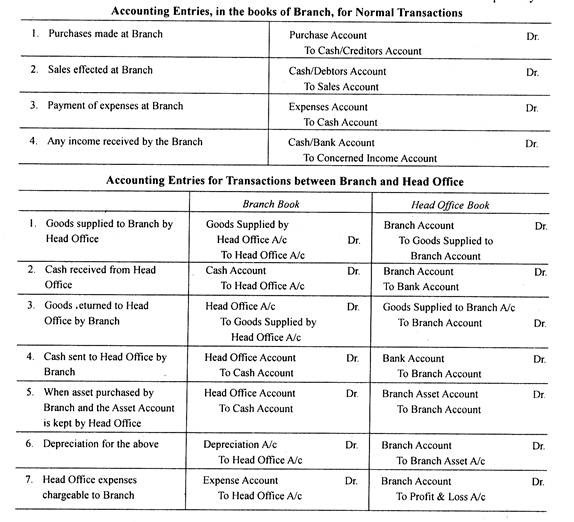
Accounting journals for regular transactions
Inter-branch transactions:
If the head office has multiple branches, transactions may take place between them, and such transactions are called inter-branch transactions. A branch does not need to have an account at another branch. Inter-branch transactions are treated as transactions with the head office.
The entries are:

Example

Solution:
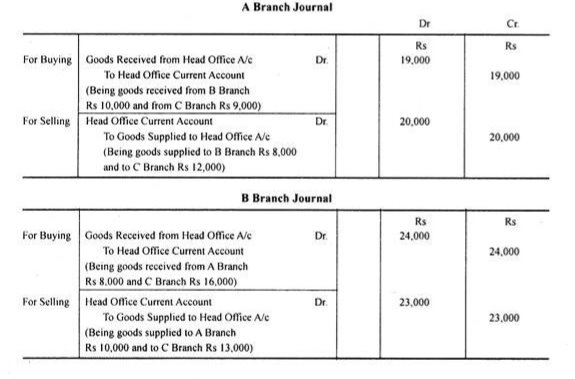

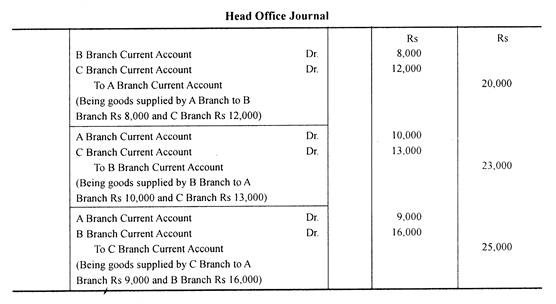
Items in transit:
Generally, the balance of the branch's checking in the head office's books is the same as the balance of the head's checking in the branch's books. The balances of these current accounts must be the same, but on the opposite side of both books.
The difference occurs in the following situations:
1. If the branch sends goods or cash to the head office, the branch will enter it in the head office account. However, the same is recorded in the headquarters books only upon receipt of goods or cash. For example, goods or cash sent by a branch just before the end of a fiscal year may not reach headquarters in the same fiscal year.
Therefore, the branch accounts are not credited in the head office books, but the head office accounts are debited in the branch books at the same time. Therefore, there is a difference between the two books.
2. Similarly, the head office may send cash or goods to the branch office. When you submit them, the branch checking account will be debited to the headquarters books. If the item is not received by the branch book, the corresponding entry will not be passed to the branch book.
In this way, goods or cash sent from the head office to the branch office or from the branch office to the head office and not received by the recipient are called in transit.
1. If the goods or cash sent by the branch is in transit, the following entry will be passed.
Goods or cash sent from the branch are in transit
The above entries will remain on the books for a short period of time or until the cash or goods in transit arrive. If the recipient receives the goods or cash in transit, the shipping account will be closed because you need to cancel the entry.
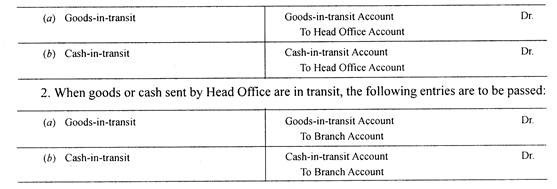
Incorporation of branch trial balances into head office books:
If a branch is dependent, it is relatively easy to incorporate the branch results because the accounting for such a branch is done at the headquarters itself. Profit is transferred from the branch account under the debtor system or the branch adjustment account under the stock debtor system to the general profit and loss account. An independent branch with its own accounting system creates a trial balance and sends a copy to the headquarters.
After receiving the trial balance from the branch, the head office passes a built-in entry to prepare the balance sheet combined with the branch's transactions and income statement. With the help of the branch trial balance, the head office records in a book about the branch. This process is known as the integration of branch trial balances.
There are two ways:
(A) Incorporation of all items into the trial balance:
The item is divided into two parts.
(A) Items related to trading and income statement
(B) Items related to the balance sheet.
After passing the above six journals, Headquarters creates branch transactions and P & L accounts.
Closing entries if head office wants
Items related to the balance sheet
After passing all eight of these entries, the total debit of the branch accounts equals the total of the crediting branch accounts, so the branch accounts in the head office books are automatically balanced. That is, if branch assets and liabilities are included, the branch accounts in the head office books created and incorporated after adjustment do not leave a balance.
If the assets and liabilities of the branch are not included, the branch accounts in the head office books created by the above method will leave a closing balance equal to the net assets (assets minus liabilities) as of the closing date.
(B) Incorporation of branch net income / loss, liabilities and assets:
Instead of transferring all items, the branch can create transactions and profit and loss accounts and transfer only net income or net loss to headquarters with or without assets and liabilities.
If assets and liabilities are transferred, the headquarters will not leave a balance. However, if assets and liabilities are not transferred, the head office account will have a balance equal to net worth. However, at the time the consolidated balance sheet was created, this account was replaced by branch assets and liabilities.
Example:
The Chennai company has two branches in Mysore and Bangalore. Headquarters and branches will close their books on December 31st.
The next adjustment is not yet enabled, so you need to enter the next adjustment entry.
(A) A remittance of 4.500 rupees sent to the head office by Mysore on December 30 received by the head office on January 5th.
(B) A product worth 2,000 rupees shipped from the Bangalore branch on December 27 and received by the Mysore branch on December 30 based on instructions from the head office.
(C) The depreciation of the assets of the Mysore branch is Rs 1,100 and the account for such assets is maintained by the head office.
(D) A product worth Rs 9,000 shipped from the head office to the Mysore branch on December 30 was received by that branch on January 7.
Display the entry in the head office book.
Solution:
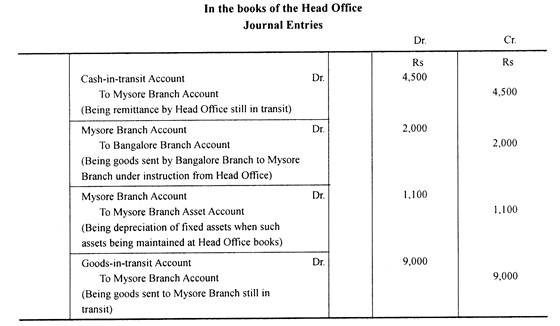
Example
Mangalore's headquarters had branches in Putter and Udupi. Assuming the book was closed on March 31, 2006, enter an entry in the book at headquarters to correct or adjust the following:
(1) Expenses, Rupees 4,800, will be charged for work done by the head office on behalf of the Udupi branch.
(2) Puttur Branch paid Rs. Salary for visiting headquarters staff is 3,600. The branch credited the amount to the payroll account.
(3) Depreciation at an annual rate of 10% Rs will be charged to Puttur furniture. 10,000, that account is at headquarters.
(4) Products that cost Rs. Headquarters purchased 2,400 from D'Souza Brothers, paid by Puttur Branch.
(5) Remittance of rupees. The 3,750 created at headquarters from the Udupi branch on March 28, 2006 was received at headquarters on April 1, 2006. (B.Com, Mangalore)
Solution:
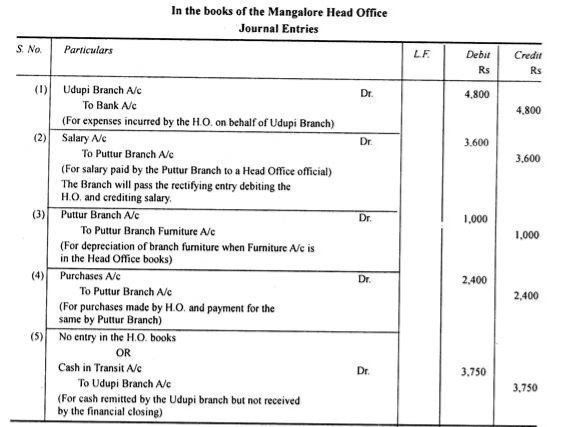
Example
Eve Ltd in Calcutta and Delhi branches. You need to prepare your trading and P & L accounts and your consolidated balance sheet. After incorporating the assets and liabilities, create a journal to include the Delhi branch account in the headquarters and the branch account in the headquarters books.
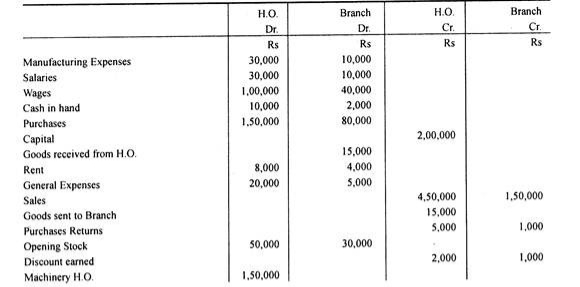
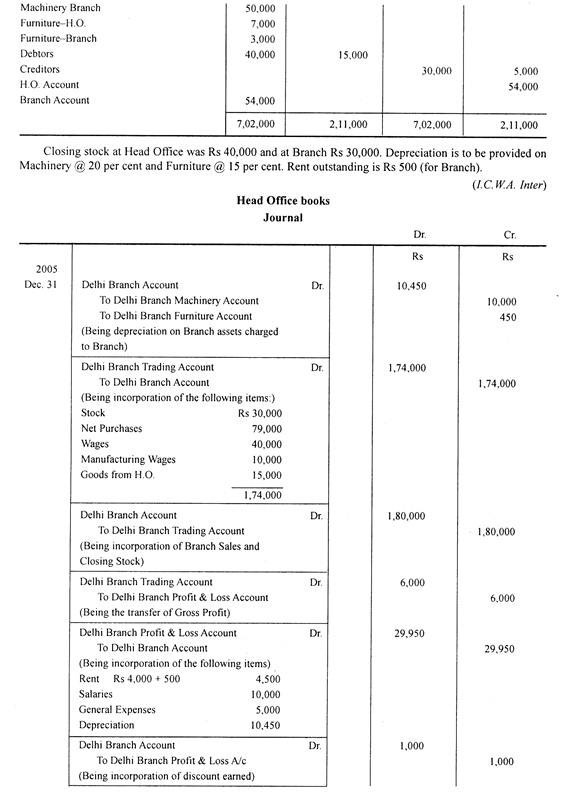
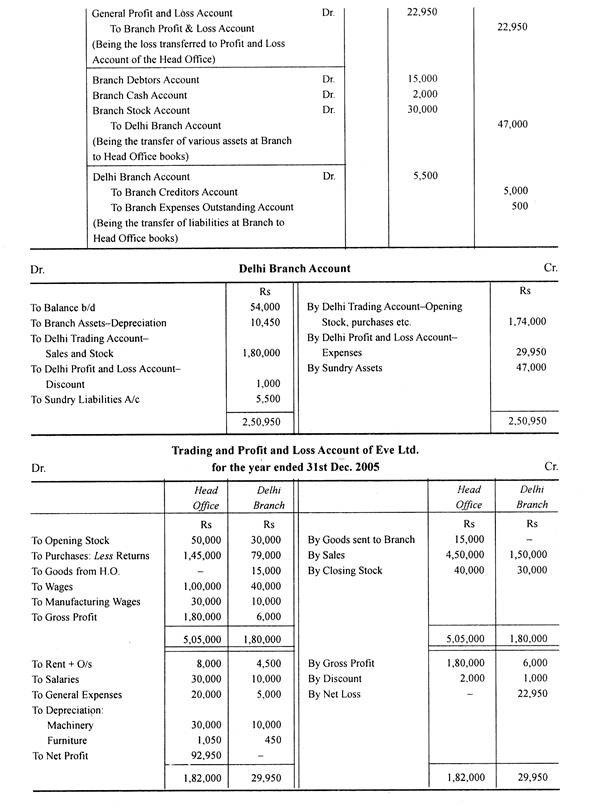
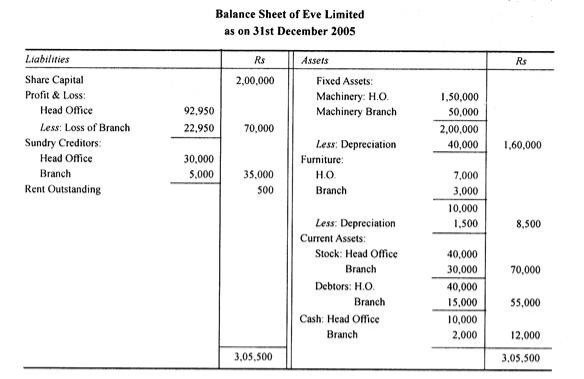
Example
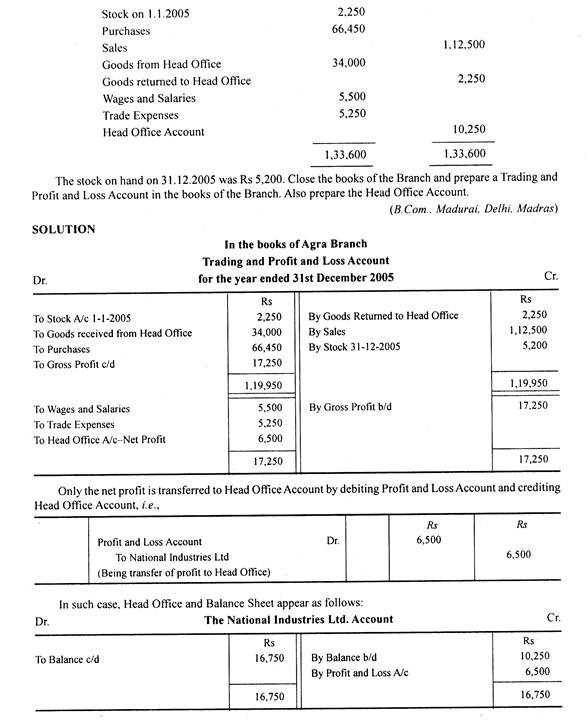
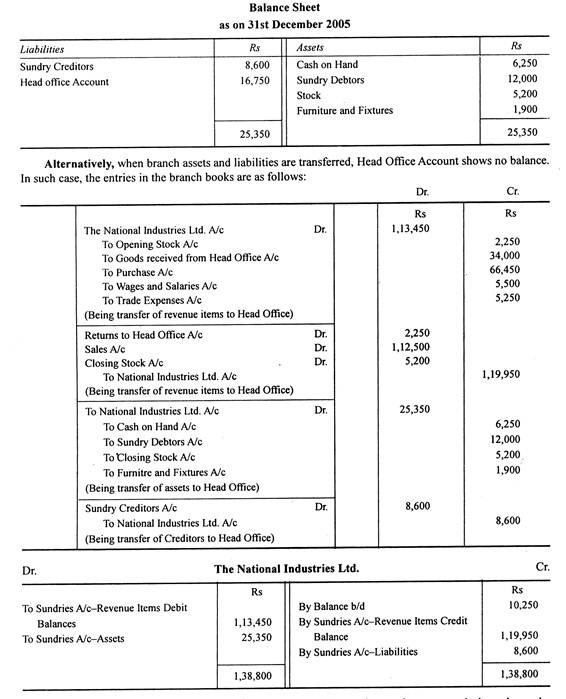
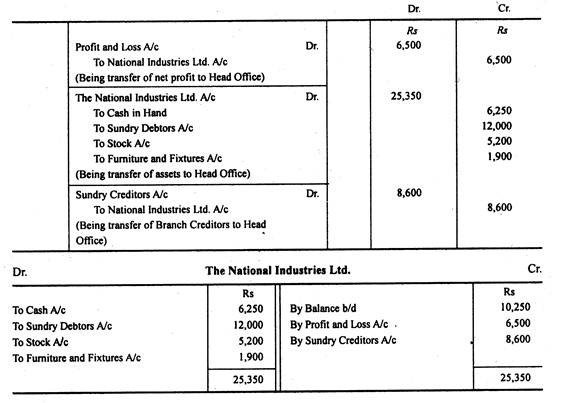
References:
- Accounting Notes of Delhi University/Mumbai University.
- Accountingnotes.com
- Accounting Article Library.
- Https://www.yourarticlelibrary.com/accounting/branch-accounts/maintaining-accounts-of-an-independent-branch/51650#:~:text=Independent%20Branches%20are%20those%20which,freedom%20like%20an%20American%20Son.
- Https://edurev.in/question/735175/What-is-meant-by-indepandent-branch-in-Branch-Ac-i
- Https://commerceiets.com/different-types-of-branches/
- Https://www.zeepedia.com/read.php?independent_branch_advanced_financial_accounting&b=21&c=15